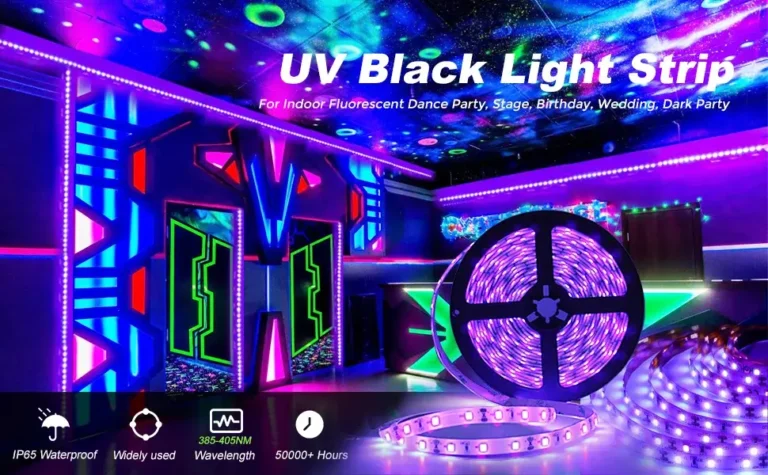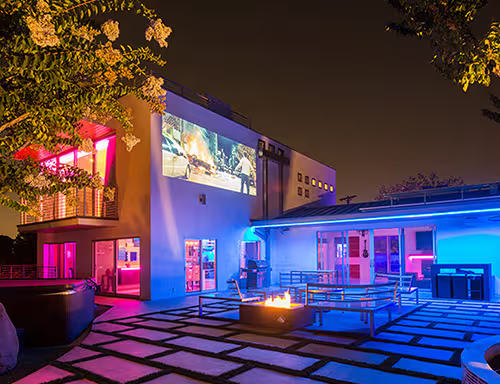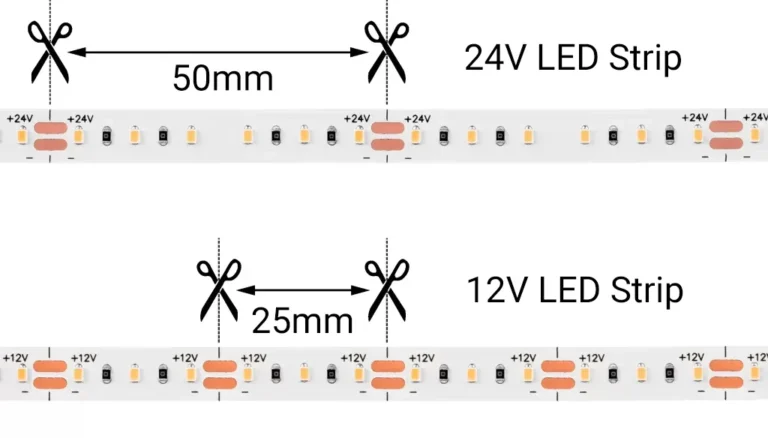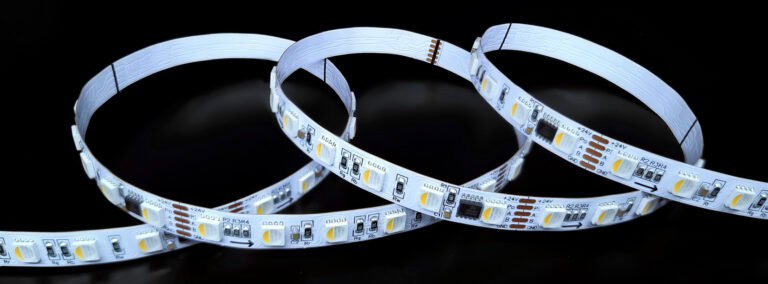W rzeczywistych projektach oświetleniowych, konstrukcji pokoi modelowych lub na miejscu, nierzadko zdarza się, że paski LED 12 V są podłączone do zasilania 24 V z powodu niespójnych konfiguracji zasilania. Chociaż może się to wydawać zwykłą „niedopasowaniem napięcia”, może to prowadzić do poważnych problemów, takich jak spalone diody LED, przegrzanie i palenie, awaria produktu, a nawet opóźnienia w projektach.
Dla integratorów taśm LED, wykonawców oświetlenia architektonicznego i nabywców hurtowych znalezienie alternatywnego rozwiązania technicznego bez wymiany całego systemu stało się kluczowe.
W tym artykule systematycznie analizujemy:
- Zasady działania i ryzyko niedopasowania napięcia
- Ograniczenia aplikacji taśm LED 12V w systemach 24V
- Realne rozwiązania redukcji napięcia i izolacji
- Jak wybrać bezpieczny projekt zasilania na podstawie scenariuszy projektu
Jeśli szukasz stabilnego i opłacalnego rozwiązania, artykuł zamieści również zalecane produkty z taśmy LED i sugestie dotyczące pomocy technicznej na końcu.
Dlaczego paski LED 12V nie mogą być używane bezpośrednio z zasilaczem 24 V?
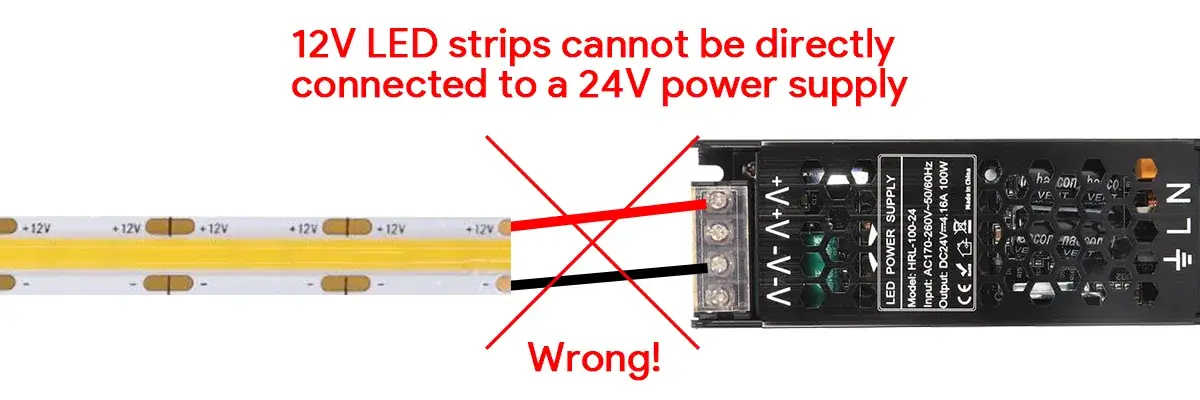
W projektach oświetleniowych LED 12V i 24V to dwa najpopularniejsze standardy niskiego napięcia. chociaż Taśmy LED 12V i 24V Wyglądają podobnie pod względem struktury, ich wewnętrzne projekty obwodów, rozkłady rezystorów i pojemności przenoszące prąd są zupełnie inne. Podłączenie paska 12V do źródła zasilania 24 V spowoduje bezpośrednie przeciążenie napięcia, co prowadzi do następujących poważnych konsekwencji:
Konsekwencje nadmiernego napięcia
Pasek 12V działa przy napięciu 12V. Po podłączeniu do źródła zasilania 24 V DC jest poddany dwukrotnemu napięciu znamionowemu, przekraczając jego limit. Typowe problemy to:
- Natychmiastowe wypalenie chipów LED: Chipy LED są zaprojektowane do pracy przy prądzie 12V. Po podłączeniu do 24V prąd podwaja się, powodując poważne przegrzanie, co może prowadzić do wypalenia lub przebarwienia wióra LED.
- Odporność na przegrzanie Uszkodzenie: Rezystory ograniczające prąd podłączone szeregowo w taśmie LED poważnie się przegrzewają, co może powodować awarię rezystora, deformację PCB, a nawet ryzyko dymu lub pożaru.
- Cały pasek świetlny stał się bezużyteczny: Po uszkodzeniu obwodu koszty naprawy przekraczają koszt wymiany całego paska świetlnego, szczególnie w zainstalowanych scenariuszach, w których jest to szczególnie trudne.
Analiza zasady stojącej za wypaleniem LED
Diody LED są zasadniczo urządzeniami napędzanymi prądem, a zmiany napięcia mogą powodować gwałtowny wzrost prądu. Zazwyczaj pasek świetlny 12 V składa się z serii trzech diod LED połączonych szeregowo, a następnie równolegle, z rezystorami ograniczającymi prąd, aby utrzymać stałą jasność. Po podłączeniu do 24V niekontrolowany prąd prowadzi do następujących zjawisk:
- Diody podłączone szeregowo tracą ochronę prądu współdzielenia: Jeśli jedna dioda LED się wypala, cała grupa przestaje działać, wpływając na cały pasek świetlny.
- Rezystory przegrzewają się, powodując zwężenie powierzchni płyty.
- Dodatni przepięcie zacisku powoduje zwarcie w obwodzie.
Ryzyko użytkowania na miejscu jest znacznie wyższe niż w warunkach laboratoryjnych
W środowisku laboratoryjnym, nawet jeśli podłączenie do 24 V przez krótki czas nie wypala paska świetlnego, ryzyko jest znacznie zwiększone w następujących scenariuszach inżynierskich:
- instalacja równoległa zbior: Zwiększone obciążenie mocy, a gdy sekcja się nie powiedzie, może łatwo wywołać reakcję łańcuchową wypaleń.
- na zewnątrz lub w załączeniu Kanał aluminiowy środowiska: Słabe rozpraszanie ciepła, prowadzące do ucieczki termicznej.
- Ukryta instalacja pasków świetlnych: Wypalenie jest wykrywane późno, co skutkuje wysokimi kosztami konserwacji.
Niedopasowanie napięcia nie jest „drobnym problemem”, ale poważnym zagrożeniem, które poważnie wpływa na żywotność, bezpieczeństwo i harmonogram dostawy w paskach świetlnych. W przypadku każdego komercyjnego projektu oświetlenia, który priorytetowo niezawodność, zapobieganie podłączeniu listew świetlnych 12 V do zasilania 24 V jest jednym z najbardziej podstawowych standardów projektowania elektrycznego.
Czy mogę bezpiecznie uruchomić diody LED 12V na zasilaczu 24V?
Technicznie tak, możesz, ale tylko wtedy, gdy połączysz je poprawnie szeregowo.
Chociaż zdecydowanie zalecamy używanie produktów i akcesoriów określonych dla prawidłowego napięcia, pokażemy Ci, jak podłączyć diody LED 12V do Zasilanie 24 V Bez uszkadzania świateł LED!
Zastrzeżenie: Nieprawidłowe lub przypadkowe połączenia powodujące przepięcie mogą spowodować trwałe uszkodzenie diod LED. Informacje podane tutaj służą wyłącznie celom edukacyjnym. Signlited nie ponosi odpowiedzialności za jakiekolwiek szkody.
Ze względów bezpieczeństwa zalecamy przetestowanie z dwoma krótkimi odcinkami tej samej taśmy LED 12 V, aby upewnić się, że wszystko jest poprawnie skonfigurowane przed podłączeniem dłuższych sekcji.
Prawidłowa metoda okablowania: połączenie szeregowe
Teoretycznie podłączenie dwóch identycznych pasków świetlnych LED 12V szeregowo daje całkowite napięcie 24 V, co czyni je kompatybilnymi z systemem 24V. Podłączając w ten sposób paski świetlne LED, zasilacz 24 V jest skutecznie „rozdzielony” między dwoma segmentami taśmy świetlnej LED, przy czym każdy segment otrzymuje 12 V. Ponieważ dwa paski świetlne LED są połączone szeregowo, każda taśma świetlna LED zużywa ten sam prąd. Szczegółowa metoda połączenia znajduje się na poniższym schemacie.

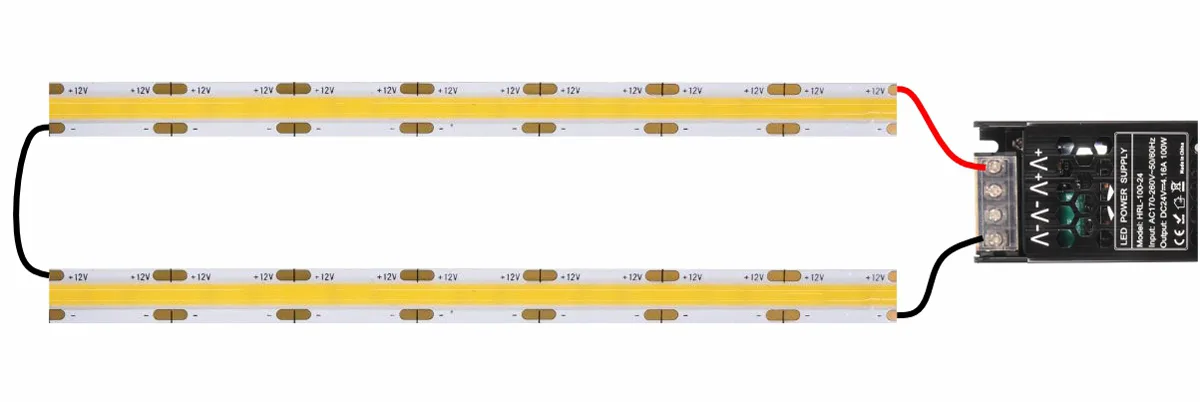
OSTRZEŻENIE: Dwie paski LED połączone szeregowo muszą być dokładnie takie same!
Dlaczego to jest takie ważne?
Załóżmy, że dwa paski świetlne LED 12V o różnych długościach są połączone szeregowo. Przy napięciu 12 V zużywają odpowiednio 0,5 A i 1,0 A prądu. Ponieważ są one połączone szeregowo, będą zmuszeni dzielić tę samą wartość prądu w przód. Załóżmy, że aktualna wartość wynosi dokładnie 0,75A (punkt środkowy).
W przypadku dłuższego paska świetlnego LED, aby dopasować do niższego prądu 0,75 A (zamiast znamionowego 1,0 A), napięcie może wymagać spadku do 11V lub nawet 10V. Jednakże, jak sama nazwa wskazuje, napięcie stałe 24V, w tym samym czasie, krótsze pasy świetlne LED są teraz zmuszone do „wyrobienia” pozostałego napięcia 13V lub 14V. Spowoduje to, że krótszy pasek świetlny LED będzie odczuwał nadprądowe warunki i może uszkodzić diody LED.
Tylko w konfiguracji szeregowej pasek świetlny LED 12V może działać na zasilaczu 24V. Chociaż ta technologia jest inteligentna, skalowalna i bardzo przydatna do celów nauczania i instalacji, może stanowić znaczne ryzyko w rzeczywistych instalacjach projektów inżynierskich:
- Należy użyć tej samej długości i rodzaju paska.
- Może wystąpić nierównomierny rozkład napięcia.
- Usterka w jednym pasku może wpłynąć na inny pasek.
Wszelkie zmiany rezystancji, niespójne lutowanie lub nierównomierne starzenie pasków mogą powodować nierównomierny rozkład napięcia, zwiększając w ten sposób ryzyko uszkodzenia. Dlatego zalecamy stosowanie tej metody tylko w sytuacjach awaryjnych!
Aby uzyskać więcej informacji na temat podłączenia świateł LED do zasilania, przeczytaj posty na blogu Kompletny przewodnik po podłączaniu taśm LED do zasilacza I Sposoby podłączania taśm LED do zasilacza.
Lepsze rozwiązania techniczne: Jak używać świateł LED 12V w systemie 24V
W niektórych miejscach projektu system zasilania 24 V został już równomiernie wdrożony. Jednak ze względu na problemy z zapasami, outsourcing lub zmiany wymagań w późniejszym etapie może zaistnieć potrzeba tymczasowego użycia świetlówek LED 12 V. Jeśli same światła paskowe LED nie mogą zostać wymienione, czy istnieje sposób na bezpieczne podłączenie ich do systemu zasilania 24 V? Odpowiedź brzmi tak, ale należy to zrobić przy użyciu profesjonalnych metod redukcji napięcia, aby zapewnić stabilność systemu i bezpieczną pracę.
Rozwiązanie 1: Użyj konwertera DC-DC obniżającego poziom
Jest to najczęstsza i najbezpieczniejsza metoda. Wkładając przetwornik obniżający prąd stały DC-DC między wyjściem zasilania a listwą LED, napięcie 24 V jest niezawodnie przekształcane na wyjście 12V, dzięki czemu listwa LED działa normalnie.
Zalety:
- Precyzyjnie wyprowadza 12V, kompatybilny ze wszystkimi modelami taśm LED 12V;
- Wiele modułów może być podłączonych równolegle do segmentowego zasilania, ułatwiając okablowanie;
- Moduły klasy przemysłowej z ochroną przed przepięciami i zabezpieczeniem przed przeciążeniem są dostępne w celu zwiększenia stabilności systemu.
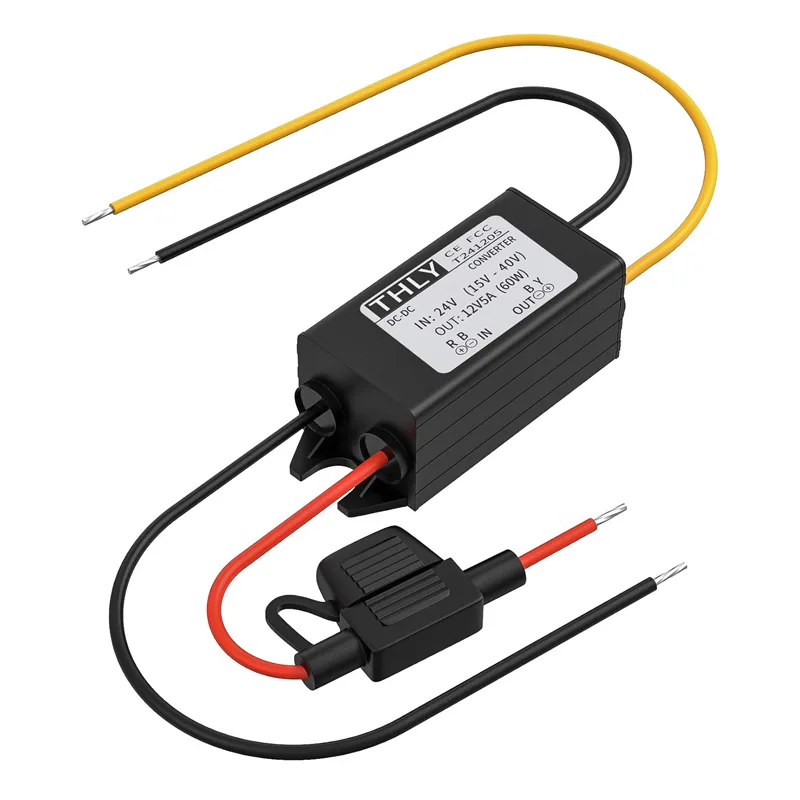
Konwerter obniżający DC24V-12V
Napięcie wyjściowe: DC12V
Maksymalny prąd: 5A 60W
Wydajność: 96%
Wodoodporność: IP67
Wymiary produktu: L114 x S79 x W20 mm
Waga netto: 264g
Scenariusze aplikacji:
- gabloty galerii handlowej i oświetlenie okien;
- Regulowane oświetlenie wystaw i ekspozycji;
- Systemy oświetlenia wewnętrznego z segmentową kontrolą.
Zalecane rozważania:
- Moc modułu musi spełniać całkowite zużycie pasków świetlnych; zaleca się pozostawienie marginesu 20%-30%.
- Preferuj produkty z funkcjami ochrony przed zwarciami i stabilizacją napięcia;
- Zwróć uwagę na rozpraszanie ciepła i hydroizolację podczas instalacji (jeśli jest używane w projektach zewnętrznych).
Rozwiązanie 2: Konfiguracja systemu podwójnej mocy (zasilanie izolowane)
W projektach średniej lub dużej skali można również zastosować podwójny system zasilania, w którym zasilacz 24 V napędza urządzenia 24V, a do pasków świetlnych zasilania 12 V dodaje się dodatkowy zasilacz 12 V.
Zalety:
- Niezależna kontrola każdego systemu dla łatwiejszej konserwacji;
- Bardziej odpowiedni dla wysokiej klasy projektów wrażliwych na zakłócenia zasilania;
- Może być wdrożony w połączeniu z inteligentnymi systemami sterowania, takimi jak DMX i DALI.
Obowiązujące scenariusze:
- wielosystemowe projekty oświetleniowe w hotelach, kompleksach handlowych, muzeach itp.;
- Łatwiejsza integracja przy dodawaniu modułów 12V podczas realizacji projektu.
UWAGI:
- Dwie grupy zasilaczy nie mogą mieć wspólnego gruntu i muszą być całkowicie odizolowane;
- Wymagane jest wyraźne oznakowanie obwodów, aby zapobiec błędom okablowania podczas wdrażania;
- System sterowania musi być pogrupowany według segmentów napięcia.
Rozwiązanie 3: Scentralizowane zasilanie + modułowa konstrukcja wyjścia (odpowiednie dla zintegrowanych systemów)
W przypadku rozproszonych systemów sterowania oświetleniem (takich jak inteligentne platformy oświetleniowe na dużą skalę) scentralizowana szafka zasilająca może być używana do jednolitego zasilania 24 V, które jest następnie przekształcane na sygnały 12 V za pomocą modułowej płyty wyjściowej.
Zalety:
- Scentralizowane zarządzanie i instalacja modułowa;
- Nadaje się do oświetlenia przemysłowego i inteligentnych systemów sterowania budynkiem;
- Zmniejsza koszty konserwacji i ułatwia diagnozę usterek.
Wady:
- wyższe początkowe koszty wdrożenia;
- Niektóre wymagania dotyczące okablowania budowlanego.
Niezalecane rozwiązania: paski świetlne podłączone szeregowo, redukcja napięcia rezystora itp.
Chociaż z perspektywy teorii obwodów redukcję napięcia można osiągnąć poprzez dodanie rezystorów szeregowych lub wielu połączeń szeregowych, a także szczegółowo opisaliśmy połączenie i zasady tego rozwiązania w poprzednim rozdziale, metody te stwarzają wysokie wskaźniki awaryjności i zagrożenia bezpieczeństwa w rzeczywistych projektach oświetleniowych:
- Paski LED podłączone do serii są znacząco pod wpływem jednorodności komponentów;
- Metody redukcji napięcia rezystora są nieefektywne i generują nadmierne ciepło;
- Rozwiązanie nie ma mechanizmów ochronnych, a wahania napięcia mogą łatwo uszkodzić sprzęt.
Dlatego w przypadku projektów profesjonalnych konieczne jest wybranie znormalizowanych modułów redukcji napięcia lub zgrupowanych systemów zasilania o stabilnych funkcjach wyjściowych i ochronnych.
Chociaż istnieją rozwiązania dotyczące problemu pasków świetlnych 12 V, które są niekompatybilne z systemami 24V, wymagają one odpowiedniego planowania i znormalizowanego wyboru. W zależności od skali projektu, środowiska instalacji i systemu sterowania, wybór odpowiedniej metody redukcji napięcia może zarówno obniżyć koszty renowacji, jak i zapewnić długotrwałą stabilną pracę systemu.
Alternatywne zalecenie: Wybierz produkty z taśmą LED z kompatybilnymi napięciami
Chociaż rozwiązanie typu step-down może umożliwić kompatybilność taśm LED 12V z systemami 24V, z punktu widzenia bezpieczeństwa projektu, stabilności i kosztów konserwacji, zalecamy wybór Produkty z taśmy LED z kompatybilnymi napięciami dla systemu od samego początku projektu. Ta strategia może skutecznie zmniejszyć wskaźniki awarii inżynieryjnych, poprawić ogólną wydajność systemu i wydłużyć żywotność.
Dlatego musisz wybrać właściwe rozwiązanie na podstawie swojego projektu. Decydując się na użycie pasków świetlnych LED 12V w systemie 24V, zadaj sobie pytanie:
- Czy to jest tymczasowa czy stała?
- Czy mogę użyć konwertera obniżającego lub dodatkowego zasilacza?
- Czy mogę bezpiecznie połączyć się w szereg?
- Czy aktualizacja do paska zasilającego 24 V byłaby bardziej wydajna na dłuższą metę?
Najbardziej praktycznym rozwiązaniem jest uaktualnienie do pasków świetlnych LED 24V. Jeśli Twój system jest już znormalizowany dla 24 V, aktualizacja może uprościć instalację i zarządzanie energią. Dlaczego 24V jest preferowane niż 12V? W porównaniu z systemami 12V, listwy świetlne LED 24V oferują znaczne korzyści w instalacjach średnich i długich:
- Niższa utrata napięcia: W tych samych obecnych warunkach utrata linii systemu 24V jest o połowę niższa niż w systemie 12 V, co czyni go bardziej odpowiednim do okablowania na duże odległości;
- Niższy prąd na jednostkę, dzięki czemu system jest bezpieczniejszy: Zmniejsza ryzyko przegrzania kabla i zwarć;
- można przerobić na dłuższe pojedyncze segmenty: Unika nadmiernego punktu łączenia, poprawiając spójność wydajności świetlnej;
- Lepsza kompatybilność z inteligentnymi systemami oświetleniowymi, takimi jak DALI i DMX: Łatwiejsze do osiągnięcia scentralizowanego zasilania i cyfrowego ściemniania.
Dlatego jeśli Twój projekt jest już systemem zasilania 24 V, wybór pasków świetlnych 24 V jest najbardziej niezawodną opcją.
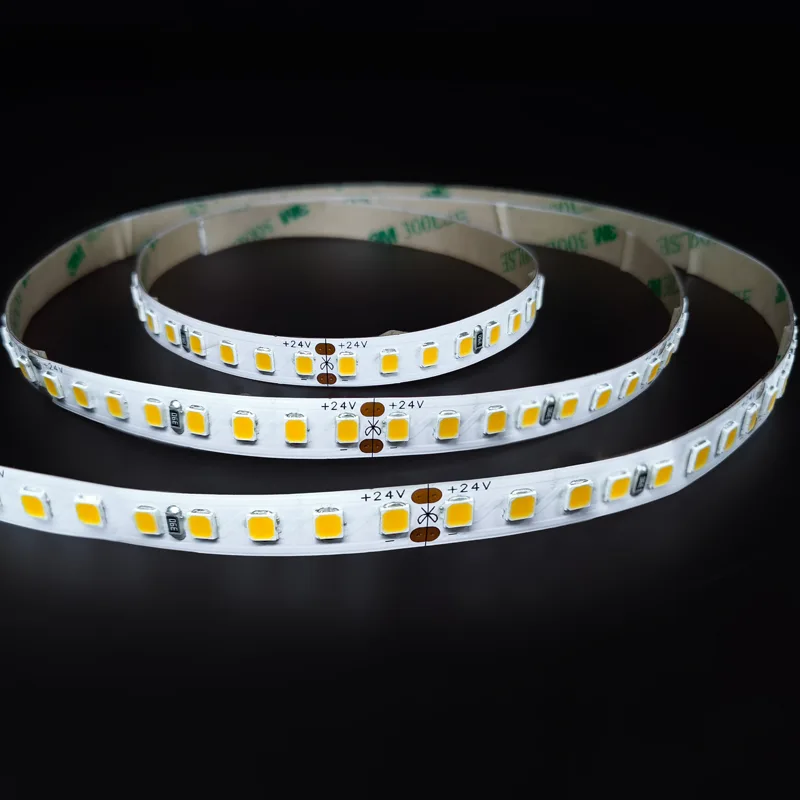
Wysokowydajna dioda LED DC24V LED
Nr modelu: FQX10T128C
Napięcie: Prąd stały 24 V
Moc: 12W/m
Efektywność: 190-200lm/W
Ra: >80
CCT: 3000K – 6500K
Typ LED: SMD2835
LED QTY: 128 diod LED/m
Szerokość PCB: 10 mm
Jednostka tnąca: 62,5 mm/8 diod LED
Stopień ochrony IP: Stopień ochrony IP20/IP54/IP65/IP67/IP68
Gwarancja: 5 lat
Zalecenia dotyczące wyboru: Wybierz odpowiednią taśmę LED napięcia dla swojego projektu
| Typ projektu | Zalecane napięcie | mędrkostwo |
| Komercyjne oświetlenie sufitowe do korytu | 24V | Długa odległość instalacji, scentralizowane zasilanie, minimalna strata linii |
| Oświetlenie okienne lub oświetlenie okienne | 12V/24V | Zależy od długości paska świetlnego i lokalizacji zasilania |
| Inteligentny system ściemniania budynków | 24V | Bardziej kompatybilny z kontrolerami DALI i DMX |
| Oświetlenie mebli na indywidualne zamówienie | 12V | Rozproszone zasilanie, różne długości pasków świetlnych i elastyczne okablowanie |
| Wodoodporny system taśm świetlnych na | 24V | Lepsza stabilność dla sterowników o dużej mocy i silniejsza odporność na napięcie |
Wybór prawidłowego napięcia jest pierwszym krokiem w określeniu sukcesu Twojego projektu. Zamiast wprowadzać poprawki na późniejszych etapach budowy, lepiej jest dokładnie rozważyć kompatybilność systemu, projekt obwodu i wydajność produktu podczas początkowej fazy selekcji, aby zapewnić jednorazową instalację i długoterminową stabilność. W rzeczywistym implementacji projektu zalecamy współpracę z dostawcami, którzy mają doświadczenie inżynierskie, aby dostosować system do potrzeb napięcia, prądu, metod sterowania i środowiska instalacji.
Jeśli nadal masz pytania dotyczące wyboru pasków LED 24 V lub 12 V, Signliteled może zapewnić następujące wsparcie:
- Zasilanie inżynieryjne i pasowanie LED systemu pasków LED;
- Moduły DC-DC Buck i rozwiązania scentralizowane zasilacze;
- Usługi zbiorcze i usługi dostosowywania OEM, odpowiednie do różnych projektów komercyjnych.
Proszę skontaktuj się z nami do oceny projektów i profesjonalnej porady.
Podsumowanie: Jak złagodzić ryzyko związane z niedopasowanymi systemami 12V/24V
W komercyjnych projektach oświetleniowych i inżynieryjnych stabilna praca systemów oświetlenia taśmowego LED zależy nie tylko od jakości samych produktów, ale także od racjonalności systemu zasilania i zgodności ze standardami instalacyjnymi. W tym artykule identyfikujemy wiele rozwiązań i analiz technicznych, które bezpośrednio podłączając paski LED 12 V do źródła zasilania 24 V, jest praktyką wysokiego ryzyka, która może łatwo prowadzić do uszkodzenia paska i przeróbki projektu.
Jeśli ze względu na wymagania projektowe lub ograniczenia zapasowe, konieczne jest użycie pasków 12 V w systemie 24V, profesjonalne moduły redukcyjne napięcia lub izolowane systemy zasilania powinny być wybrane jako środki przejściowe w celu zapewnienia bezpieczeństwa i trwałości sprzętu.
Z długoterminowej perspektywy wybór produktów taśmowych LED, które odpowiadają napięcia systemu zasilania od samego początku projektu, jest optymalną strategią zmniejszania złożoności inżynierii i minimalizowania konserwacji po instalacji.
Zalecana lista standardów elektrycznych dla projektów oświetlenia taśmowego LED
| Faza projektu | rekomendacje |
| Schematyczne fazy projektowania | Określ napięcie zasilania systemu (12V lub 24V), aby uniknąć mieszania wielu napięć |
| Wybór produktu taśmy świetlnej | Priorytetowe wybieranie wersji napięciowych zgodnych z systemem, np. listwy oświetleniowe 24 V dla systemu 24 V |
| Instalacja okablowania na miejscu | Ściśle zabroń podłączania pasków 12 V bezpośrednio do źródła zasilania 24 V; musi używać modułów obniżających DC-DC lub izolowanych zasilaczy |
| Zakup sprzętu do zasilania | Wybierz zasilacze i moduły obniżające zwarcie, przepięcie i zabezpieczenie przed przegrzaniem |
| Testowanie instalacji taśmy świetlnej | Przeprowadź testy oświetlenia segmentowego przed zainstalowaniem każdej sekcji, aby zapobiec uszkodzeniom po pełnym obwodzie zasilania |
| Realizacja projektu i akceptacja | Sprawdź, czy modele zasilaczy i listew świetlnych są zgodne, a także dokumenty schematów zasilania i planów okablowania paska świetlnego |
Jeśli Twój projekt wymaga rozwiązań kompatybilności z przepięciami, scentralizowanego projektu zasilania lub modułów niestandardowych, skontaktuj się z zespołem SignLited. Oferujemy kompleksowe Oświetlenie taśmy LED Wsparcie projektowania systemu, aby pomóc Twojemu projektowi osiągnąć efektywną dostawę i stabilną pracę.
FAQ
Nie polecamy tego robić. Nawet jeśli nie wypali się w krótkim okresie, znacznie skróci żywotność paska świetlnego i może stwarzać zagrożenie bezpieczeństwa. Niektóre lekkie koraliki mogą ulec lekkim przebarwieniu lub pogorszeniu jasności w wysokich temperaturach, a ryzyko jest trudne do kontrolowania.
To nie jest zalecane. Chociaż współdzielenie napięcia jest teoretycznie możliwe, niespójna impedancja i opór mogą łatwo spowodować, że jedna sekcja się najpierw wypali, pozostawiając drugą sekcję bez ochrony i wywołując reakcję łańcuchową.
1. Upewnij się, że moc wyjściowa spełnia łączne zużycie energii pasków LED i pozwala na margines.
2 . Moduł powinien mieć funkcje zabezpieczenia przed zwarciem, przepięciem i zabezpieczeniem przed przegrzaniem.
3. W środowiskach zewnętrznych lub wysokotemperaturowych należy zwiększyć rozpraszanie ciepła lub środki hydroizolacyjne.
Można zastosować system podwójnej mocy lub scentralizowane zasilanie + modułową konfigurację wyjścia. Kluczem jest zapewnienie fizycznej izolacji między różnymi systemami napięcia, przejrzystego okablowania, niezależnej kontroli i wyraźnego oznakowania na rysunkach.
Sprawdź etykiety listew świetlnych, etykiety interfejsu zasilania lub użyj multimetru do pomiaru napięcia roboczego. Zaleca się zarządzanie partami napięcia taśmy świetlnej przed budowami, aby uniknąć błędnych połączeń spowodowanych mieszaniem różnych napięć.
